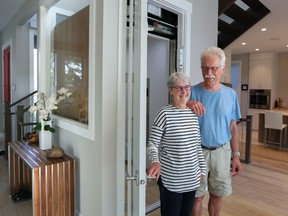Improved accessibility and aging in place are behind the trend to plan for elevators in new builds as well as renovated homes.

Reviews and recommendations are unbiased and products are independently selected. Postmedia may earn an affiliate commission from purchases made through links on this page.
Article content
When Fiona and Simon Lucchini were building their two-storey home three years ago, they designed it with aging in mind by adding an elevator.
“We wanted to stay in our home as long as possible, and we wanted to make it more practical,” says Simon. “Adding an elevator seemed like the logical way to go.”
Article content
Gone are the days when elevators were only for shopping malls, office towers or the very wealthy.
Advertisement 2
Article content
These days, many Calgarians are adding in-home elevators to their living spaces, whether they’re building a new house or retrofitting an older home.
An in-home elevator can help you age in place or live with movement-related disabilities. An elevator can also allow multiple generations to live in one home, making it easier to move people, groceries, furniture, you name it, from floor to floor.
“Twenty years ago, a lot of people associated home elevators with wealthy people or people in wheelchairs,” says Chris Gallant, owner and director of Cambridge Elevator.
“But there’s been a real shift to people who are planning toward staying in their home forever, and an elevator can help with that.”
Business has been growing substantially for Gallant, who has seen demand for in-home elevators skyrocket in the past 20 years.
“Some people are willing and able to pay more to get a house that’s fully accessible,” he says. “An elevator can add up to 10 per cent to a home’s value.”
A couple of decades ago, only about 10 per cent of Cambridge Elevator’s clients wanted to retrofit an older home, adding an elevator to an existing house. These days, that number has grown to about 50 per cent of Gallant’s clients.
Article content
Advertisement 3
Article content
What has changed?
“I think during the pandemic, people realized how important their homes were and they didn’t want to go into a long-term care facility,” he says.
With an elevator, they can move between each storey of their home without the potential falling hazards and physical strain that the stairs may cause.
Cambridge Elevator works with builders across the province during the construction phase of a new home, and Gallant even sometimes works with realtors, examining homes for retrofitting potential for buyers who need an elevator but don’t want to go through the new build process.
There are all kinds of elevators for all kinds of homes, too, says Gallant, whose business has a showroom in Calgary for people to check out options. Prices vary, but many are available in the $30,000 to $60,000 range.
Some are small enough for one person and a couple bags of groceries. Most are big enough for a wheelchair to easily move in and out. Others are even larger.
Some are hidden from view; others are clearly visible. Some have doors that swing out; others have the sliding doors that we see in, say, office towers.
Advertisement 4
Article content
Depending on what’s needed, it can take as little as two days to install one.
Gallant’s team recently worked with a builder to install elevators in every unit of a 44-unit condo development. The condos are four storeys high, so with an elevator, owners can drive into their basement garage and bring their shopping easily to whatever floor they want.
An elevator also makes a home’s space more useful. Laundry can be easily transported to a basement, for instance, and kitchens can be located on a top floor to take advantage of mountain views.
“If you have an elevator, you can really take advantage of those views,” Gallant says.
Tony and Lina Ribecco are the co-owners of Grandscape Homes, a custom luxury home builder in Alberta and British Columbia’s Okanagan Valley. They have also noticed an increase in people requesting elevators in their custom home builds, and if they can’t justify an elevator at the time of building, they’re often still asking for a closet space roughed in as preparation for an elevator in the coming years.
“Even younger couples, they’re starting to think about longevity and staying in their homes as long as they can,” Lina says.
Advertisement 5
Article content
“Then there are couples who are older, very active. They want those amenities that long-term care offers, but in their own home. An elevator is one of those things.”
As for the Lucchinis, who are in their late 60s and early 70s, they don’t currently use their elevator a lot.
“We strive to be as active as possible, and going up and down the stairs is good exercise,” says Simon.
But Simon had an ankle injury while hiking a while ago and found that the elevator made his life easier and safer.
“It would be pretty silly to go up and down the stairs and risk falling, when you have an elevator,” he says.
“We are active and we can do things now, but we also know that can easily change. We like knowing the elevator is there if we need it.”
Article content
Originally posted 2023-11-10 19:07:20.